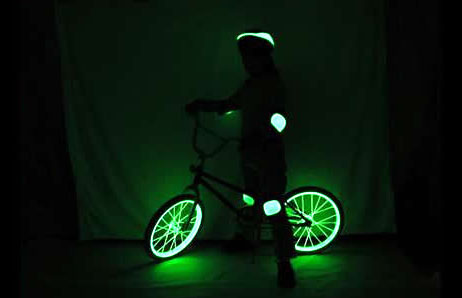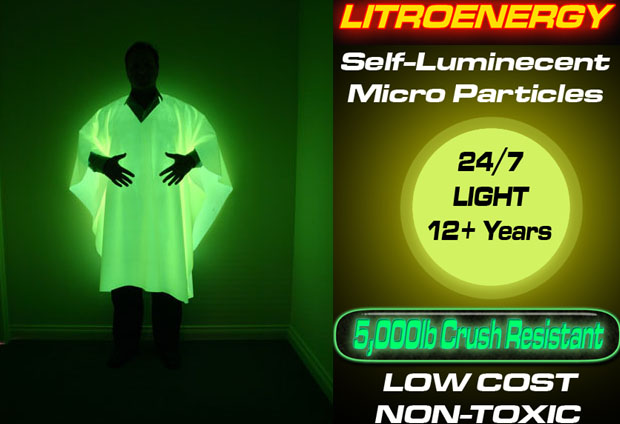How about a glowing light source that lasts for 15 years instead of the typical 15 minutes of a glowstick? GlowPaint‘s newest product does just that and is also non-toxic and inexpensive and doesn’t require a recharge via solar or electrical sources for its entire lifespan. According to the company, “This has potential to save billions in energy costs world-wide. Litroenergy™ surpasses all known available lighting options for cost/durability/reliability and safety.” Their products are expected to be used to replace other forms of safety, emergency and novelty lighting duties normally performed by glow sticks, LEDs and other light sources.

“The Litrospheres are not effected by heat or cold, and are 5,000-pound crush resistant. They can be injection molded or added to paint. The fill rate of Litroenergy micro particles in plastic injection molding material or paint is about 20%. The constant light gives off no U.V. rays, and can be designed to emit almost any color of light desired.” PureEnergySystems

Litroenergy was also submitted to the Nasa Create the Future Design Contest to compete based on its originality and potentially major impact on sustainable energy technology. More information can be found via GlowPaint’s online patent application though much of their research remains proprietary.

when and where can I buy some? 🙂
when and where can I buy some? Please send me info.
There are too many applications for this, where to start?
sounds expensive
Make a cool Tron costume.
Would be very nice for emergency vehicals, also.
Why yes, I would love a jacket that glows in the dark because it is full of radioactive gas. That sounds great… And they thought that lead was bad in paint. Soon China will be returning toys to the US because we painted them with glow in the dark radiation…
((( daniel says:
December 29th, 2007 at 1:59 am
Why yes, I would love a jacket that glows in the dark because it is full of radioactive gas. That sounds great… And they thought that lead was bad in paint. Soon China will be returning toys to the US because we painted them with glow in the dark radiation…)))
Just so you know, that monitor your using to type stuff like that is beaming radiation in to your head along with countless other household items.
Yes the jacket is 5,000 pound crush resistant….but your body isnt
Hehe, these work because they’re radioactive
Wait till a rapper gets his hands on this. Glowing grillz, slimer 26’s on the glowing escalade. oh my!
Soylent Green is PEOPLE!!!
lol pretty soon you can use this shizzle to underglow ur car. im lookin forward to it, if u can let me know when and where it will be available.
What’s wrong with a bit of darkness?
That is truly amazing practical solution of so many ‘night problems’. This company is going to make a fantastic profit, if they are really going to bring this product to the market.
Is there a catch? Maybe non-toxic to use, but what about to produce? Seems too good to be true, but then again … *could* it be all good? If so, will big coal and oil buy this technology and then bury it (or whatnot)? We sure need technologies similar to this to start taking wing. ‘Course I also worry about application and durability. Disposability is what our businesses thrive on. All the petrol-plastic ever made still exists in our environment, and this surely will be used with plastic, as it can be mixed in. Ugh, glowing trash… What we really need is to stop acquiring things (which we typically abandon using within 6 months) and instead go plant a garden. Ok, off my soap box…
Sounds like they’re using tritium, which is totally safe. The beta particles released are low energy and can’t penetrate anything for the most part, including your skin. Also, tritium is a gas, so any breakage would result in tritium being released and dissipated in the air, which is harmless. Why do I know? Because I searched high and low for a tritium watch and read all about the stuff. It’s pretty uber.
Yeah Maxxy, you could almost replicate Automan’s car.
Radio active nano-particles. Just what the world needs.
I am skeptical. With the displayed level of brightness, maintained over 15 years, represents a large amount of energy. What kind of “radioactive gas” would release that much power?
Who ever said that it is powered by radium?
I’m quite interested in how it works but we shouldn’t assume that science has lept back to 1950’s America where watch hands were painted with the stuff. Also LCD screens don’t emit radiation.
Sounds like this is nothing more than tritium in microbeads. which is not really what you want possibly floating into your watersource.
Ik wil, ik wil….(I want, I want..)
Where the hell have you lot got “radioactive” from? It clearly says on their homepage “non-radioactive”. Learn to read and stop scare mongering.
it lasts for 15 years…what happens when you want to “turn it off”?
Can this be added to the paint used in the “yellow lines” on highways??
Maybe paint a few guard-rails too.
Make the highway systems look like Tron!
All joking aside. This technology has the possibility of saving many lives. Buy your stock in this company early.
If this is made of Tritium which I bet it is (half life of Tritium ~ 12.3 years). I thought the US banned the importation and commercial use of this stuff. They do use it in nuclear weapons. They never let us have any fun.
Kids:
What’s really “amazing” is a skill called “critical thinking.” Think. Read.
Too bad they can’t use a gas with a longer half life, that would be awesome. But they are all probably too radioactive to be used, depending on exactly how resistant to electron penetration the glass and polymer walls are. If they are actually 100% resistant, or very close to it, then i dont see why they couldn’t use a different, longer half life gas. You might be able to make these things last for decades or even a century or more.
Tritium?
Homeland Stupidity already limits TRitum into the Country for fear of contamination \ dirty bombs etc.. how is this different?
What is the active ingredient?
Anyone?
LOL ok nevermind…
I just read the patent app…
2. A self-luminous microsphere as set forth in claim 1, wherein the gas is tritium.
Good luck selling it in the states or buying it. I’ll bet consumers never see the stuff.
You gan buy it here:
http://www.glopaint.com/24orders.htm
How about tattoo ink?
Traffic signs, road paint, emergency exit lights, communications towers, bikes, sporting goods, golf balls, dog collars, and more! If the paintable stuff does work well, then we just saved millions in energy, but also lives. When the street lights go out, the signs will glow and the lines on the road will be visible at any time, day or night!
According to their website “Our products are LEAD FREE and Non-Radioactive!”
Finally: this is the thing to coat a hockey puck with so we can see it on TV.
A light source that lasts for 15 years on it’s on, and yet, battery technology remains the same as long as it keeps making companies rich. When is someone going to convert something like this into usable amps to power our devices for 15 years?
Summary:
Tiny glass balls filled with a stuff that glows when hit by electrons, and gas that spews out electrons.
The electrons cannot penetrate the gas balls, so it’s safe.
The glass balls are so small that if damaged, the escaping gas is negligable.
And yes it is using radiation – beta – which is not considered dangerous (how this paint works is conceptually the same as how a CRT monitor works).
How about a glowing jumpsuit for when i am riding my motorcycle at night. Wait’s for the next Driver to say (s)he didn’t see him.
lcd screens do emit radiation, it’s called light…
Y’all, we can’t use these for road markings, the microshpere’s crush at 5000lbs of pressure. If I load up my single axle, two wheel trailer to 11000 GVW, then every time I change lanes, I’ll be releasing tritium into the atmosphere, and blacking out the road lines.
The company is playing fast and loose w/ the “non-radioactive” claim. Maybe they mean no radioactivity is released from the product, but considering that they use tritium (3H), it definitely contains radioactive material. The comparison #7 made to monitors isn’t really valid, 3H emits ionizing radiation, a monitor (or flashlight) emits non-ionizing radiation, BIG difference. Still, a couple of nanocuries of 3H shouldn’t be a big deal. 3H is used in Luminox watches right now, so it’s not really novel, probably just miniaturized so that it can be used in paints, etc.
Looks like this is indeed Tritium and IS INDEED radioactive, just another way to put more deadly particles of radioactive waste into our environment. Sure they claim none of the Tritium can escape, please remember scientists make mistakes, and salesmen will willingly sell anything to make a profit, even if it kills the whole planet after they make the sale.
Ok… you people do realize that this is vaporware and basically amounts to a meaningless publicity stunt…?
There is nothing whatsoever on the website that details anything about how this magical material actually functions or from where it obtains its absurdly abundant energy.
The “award” they got from NASA was basically for having the coolest-sounding idea… they are not required to explain how it works or actually demonstrate that they have created anything.
Believe it when there’s something in the store you can pay money for. Right now it’s just snake-oil, and you’re a sucker for buying into it.
I like The Tron Idea, all roads and guardrails…Cooool 🙂
Analog Science Fact & Fiction ran a story once about windows that captured the past and let it out again years later. A man who had lost his family had the windows in his house, showing the family scenes from years ago. Readers wrote in explaining that such a window would contain so much energy it would be hazardous, to put it mildly. So how is this new invention supposed to contain so much energy to provide all that endless illumination locked inside it, without being dangerous to health and safety?
I wanna glow while i sleep,i hope it’s gonna be available soon.
from Wikipedia:
“The low-energy beta radiation from tritium cannot penetrate human skin, so tritium is only dangerous if inhaled or ingested.”
Sounds as safe as lead paint.
I do believe I need a tat…..
Just be sure not to let Doc Ock find out where you store all the Tritium.